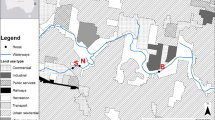Abstract
In pink-footed goose (Anser brachyrhynchus) wintering in Denmark, The Netherlands and Belgium, the proportion of juveniles in the hunting bag is consistently higher than that observed in the autumn population. Such juvenile bias in the bag is usually ascribed to young geese lacking experience with hunting or disruption of juveniles from families. An alternative explanation may be that flocking behaviour of families make juveniles more vulnerable. Observations of morning flights of pink-footed geese to the feeding grounds from two of the major autumn-staging areas showed that geese were distributed in many small flocks (median flock size = 9). This was not significantly different from the flock size distribution shot at by hunters (median = 8), suggesting that hunters targeted goose flock size in proportion to the general probability of encounter. The rate at which hunters downed geese was independent of flock size. The ratio between juveniles and adults in flocks decreased with flock size and flocks of <60 individuals primarily comprised family groups. The likelihood of being shot at was 2.4 times higher for juveniles and 3.4 times higher for older birds in small flocks (<10 individuals) compared to larger flocks. The observations suggest that both juveniles as well as successful adult breeding birds were more vulnerable than non-breeding/failed breeding birds as a result of flocking behaviour.



Similar content being viewed by others
References
Abrahams MV, Dill LM (1989) A determination of the energetic equivalence of the risk of predation. Ecology 70:999–1007
Black JM, Carbone C, Owen M, Wells R (1992) Foraging dynamics in goose flocks: the cost of living on the edge. Anim Behav 44:41–50
Boyd H (1953) On encounters between wild white-fronted geese in winter flocks. Behaviour 5:85–129
Boyd H, Smith GEJ, Cooch FG (1982) The lesser snow geese of the eastern Canadian Arctic. Can Wildl Serv Occ Paper 46:1–23
Clausager I (2001) Wing survey from the hunting season 2000/01 in Denmark. NERI Technical Reports No. 364. National Environmental Research Institute, Rönde
Dufour KW, Ankney CD (1995) Hunting mortality of mallards Anas platyrhynchos in relation to time of day, flocking behaviour, and individual condition. Wildl Biol 1:89–96
Ely CR (1993) Family stability in greater white-fronted geese. Auk 110:425–435
Fox AD, Madsen J, Boyd H, Kuijken E, Norriss DW, Tombre IM, Stroud DA (2005) Effects of agricultural change on abundance, fitness components and distribution of two arctic-nesting goose populations. Global Change Biol 11:881–893
Francis CM, Richards MH, Cooke F, Rockwell RF (1992) Changes in survival rates of lesser snow geese with age and breeding status. Auk 109:731–747
Ganter B, Madsen J (2001) An examination of methods to estimate population size in wintering geese. Bird Study 48:90–101
Giroux J-F, Bédard J (1986) Sex-specific hunting mortality of greater snow geese along firing lines in Quebec. J Wildl Manage 50:416–419
Greenwood H, Clark RG, Weatherhead PJ (1986) Condition bias of hunter-shot mallards (Anas platyrhynchos). Can J Zool 64:599–601
Grieb JR (1970) The shortgrass prairie Canada goose population. Wildl Monogr 22
Heitmeyer ME, Frederickson LH, Humburg DD (1993) Further evidence of biases associated with hunter-killed mallards. J Wildl Manage 57:733–740
Hochbaum GS, Walters CJ (1984) Components of hunting mortality in ducks. Can Wildl Serv Occ Paper 52
Lima SL, Dill LM (1990) Behavioural decisions made under the risk of predation: a review and prospectus. Can J Zool 68:619–640
Madsen J (2001) Can geese adjust their clocks? Effects of diurnal regulation of goose shooting. Wildl Biol 7:213–222
Madsen J, Noer H (1996) Decreased survival of pink-footed geese Anser brachyrhynchus carrying shotgun pellets. Wildl Biol 2:75–82
Madsen J, Riget FF (2007) Do embedded shotgun pellets have a chronic effect on body condition of pink-footed geese? J Wildl Manage 71:1427–1430
Martin FW, Pospahala RS, Nichols JD (1979) Assessment and population management of North American migratory birds. In: Cairns J, Patil GP, Waters WE (eds) Environmental biomonitoring, assessment, prediction and management—certain case studies and related quantitative issues. Stat Ecol Ser Vol II. Int Coop Publ House, Fairland, pp 187–239
Noer H, Madsen J, Hartmann P (2007) Reducing wounding of game by shotgun hunting: effects of a Danish action plan on pink-footed geese. J Appl Ecol 44:653–662
Olson DP (1964) Differential vulnerability of male and female canvasbacks to hunting. Trans N Amer Wildl Natl Res Conf 30:121–134
Owen M (1980) Wild geese of the world. Batsford, London
Owen M, Black JM (1990) Waterfowl ecology. Chapman and Hall, New York
Prevett JP, MacInnes CD (1980) Family and other social groups in snow geese. Wildl Monogr 71:3–46
Raveling DG (1969) Social classes of Canada Geese in winter. J Wildl Manage 33:304–318
Reinecke KJ, Shaiffer CW (1988) A field test for differences in condition among trapped and shot mallards. J Wildl Manage 52:227–232
Suhonen J (1993) Predation risk influences the use of foraging sites by tits. Ecology 74:1197–2103
Teunissen W, Spaans B, Drent RH (1985) Breeding success in Brent Geese in relation to individual feeding opportunities during spring in the Wadden Sea. Ardea 73:109–119
Wright G, Boyd H (1983) Number, age and sex of greylag and pink-footed geese shot at Loch Leven National Nature Reserve, 1966–1981. Wildfowl 34:163–167
Acknowledgements
Fred Cottaar is thanked for contributing to autumn population age ratio counts. Ib Clausager, Tony Fox, Magella Guillemette, Rob Clark, Henning Noer and three anonymous referees gave constructive suggestions to the manuscript.
Author information
Authors and Affiliations
Corresponding author
Additional information
Communicated by H. Kierdorf
Rights and permissions
About this article
Cite this article
Madsen, J. Age bias in the bag of pink-footed geese Anser brachyrhynchus: influence of flocking behaviour on vulnerability. Eur J Wildl Res 56, 577–582 (2010). https://doi.org/10.1007/s10344-009-0349-1
Received:
Revised:
Accepted:
Published:
Issue Date:
DOI: https://doi.org/10.1007/s10344-009-0349-1




